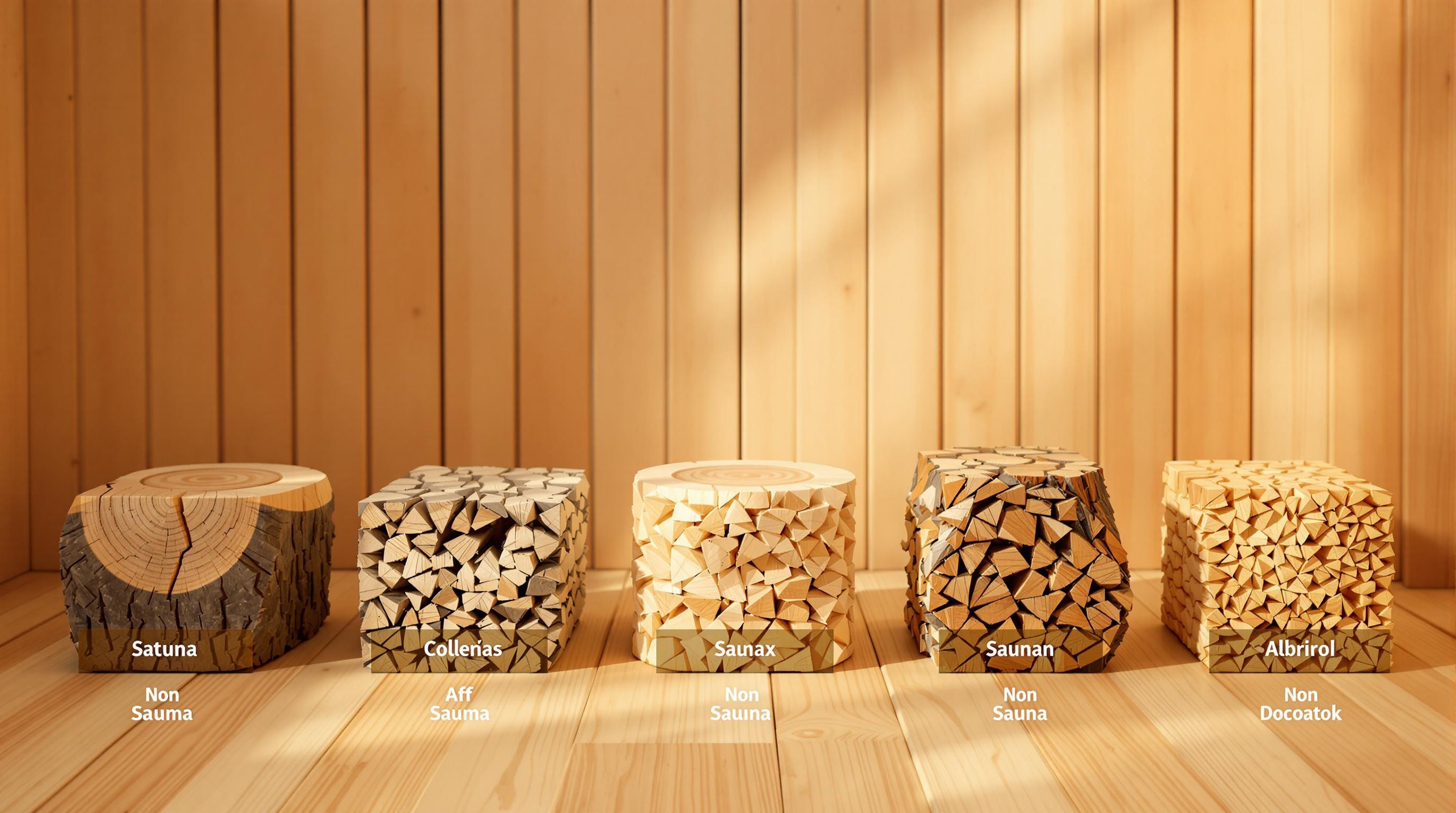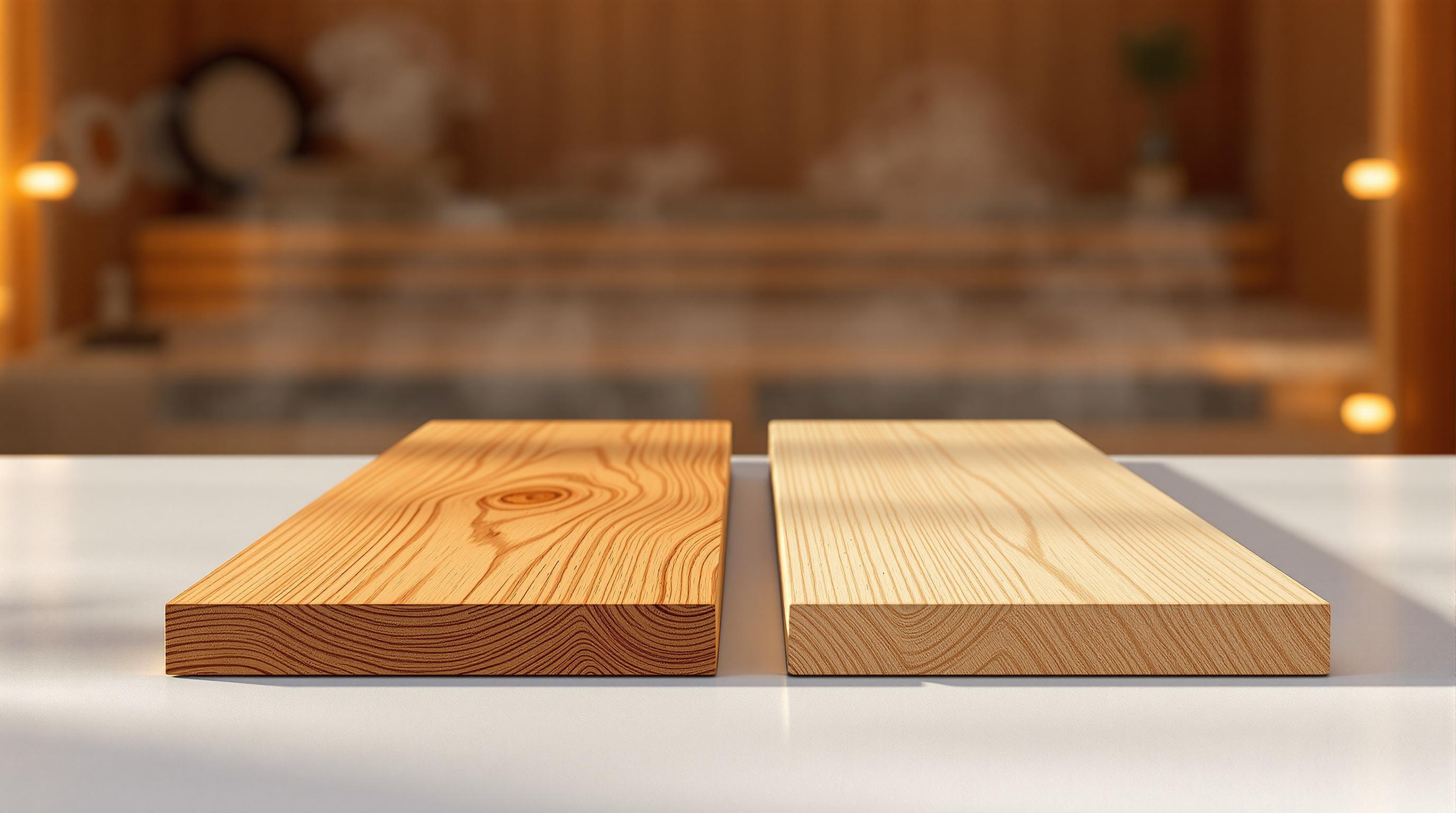Which sauna is right for you? It depends on your goals, space, and heat preferences. Here’s a quick breakdown:
- Traditional Saunas: Operate at 150-195°F with adjustable humidity. They rely on wood-burning stoves or electric heaters to heat the air and stones, creating an intense, classic sauna experience. Ideal for short, high-heat sessions (10-20 minutes) and group use, but they require more space, ventilation, and maintenance.
- Infrared Saunas: Use 110-140°F direct body heating with infrared lamps. They provide a gentler, drier heat for longer sessions (30-45 minutes). Compact, energy-efficient, and easier to install, they’re perfect for individual use and frequent sessions.
Quick Comparison
| Feature | Traditional Sauna | Infrared Sauna |
|---|---|---|
| Temperature | 150-195°F | 110-140°F |
| Humidity | Adjustable (with water) | Minimal (fixed) |
| Session Length | 10-20 minutes | 30-45 minutes |
| Energy Use | Higher | Lower |
| Installation | Requires more space/ventilation | Compact, easy setup |
| Heat Type | Heats air and stones | Direct body heating |
| Maintenance | Regular upkeep needed | Low maintenance |
Both saunas offer health benefits like improved circulation and stress relief. Traditional saunas focus on surface-level sweating, while infrared saunas penetrate deeper into the skin. Choose based on your space, heat tolerance, and wellness goals.
Main Differences Between Traditional and Modern Saunas
How Each Sauna Produces Heat
Traditional saunas rely on stoves or heaters to warm the air and stones, creating a surrounding heat that envelops the body. Infrared saunas, on the other hand, use lamps to directly heat the body, skipping the air entirely. This approach allows the heat to reach muscles more effectively.
Temperature and Humidity Levels
Traditional saunas operate at higher temperatures, typically between 150°F and 195°F, and let you control humidity by pouring water over hot stones to create steam. Infrared saunas work at lower temperatures, ranging from 110°F to 140°F, providing a drier and gentler heat. This makes it easier to enjoy longer sessions without needing cooling breaks.
| Feature | Traditional Sauna | Modern Infrared Sauna |
|---|---|---|
| Temperature Range | 150°F - 195°F | 110°F - 140°F |
| Humidity Control | Adjustable with water | Fixed (minimal) |
| Heat Type | Ambient air heating | Direct body heating |
| Session Length | Shorter (15-20 min) | Longer (30-45 min) |
Energy Use and Efficiency
Infrared saunas are more energy-efficient since they heat the body directly, reducing both energy consumption and costs. Traditional saunas consume more energy as they heat the air and require more preheating time. However, they are better suited for group use, which can make them more practical in shared settings. Beyond energy use, factors like comfort and installation needs are also crucial when deciding which sauna is the best fit.
These contrasts in heat production, humidity control, and energy usage make each type of sauna suitable for different needs and preferences.
Comfort and Ease of Use
Session Length and Heat Levels
Traditional saunas operate at high temperatures (150°F-195°F), limiting sessions to just 10-20 minutes and often requiring cooling breaks. On the other hand, infrared saunas use moderate heat (110°F-140°F), allowing for longer, more comfortable sessions of 30-45 minutes without the need for breaks. This makes them a better choice for individuals who find high heat overwhelming.
| Comfort Factor | Traditional Sauna | Infrared Sauna |
|---|---|---|
| Session Duration | 10-20 minutes | 30-45 minutes |
| Heat Intensity | High and intense | Moderate and gentle |
| Cooling Breaks | Often needed | Rarely required |
Space and Installation Needs
Traditional saunas demand more space and come with specific installation requirements. These include proper ventilation, moisture control, and either a dedicated indoor room or outdoor setup. The installation process also involves detailed planning to manage humidity and ensure adequate air circulation.
Infrared saunas, however, are much easier to install. Their compact design makes them suitable for smaller spaces, and they don’t need complex ventilation systems since they produce minimal humidity. Most infrared saunas can be set up in existing rooms with little to no modifications.
Maintenance is another area where the two differ. Traditional saunas require consistent upkeep, such as maintaining wood or electric heaters and managing humidity. Infrared saunas, in contrast, need only basic cleaning and occasional checks on the heating elements.
These practical considerations can help you decide which type of sauna aligns best with your home and lifestyle. Next, we’ll dive into the unique health benefits each sauna type provides.
Health Benefits of Both Sauna Types
Sweating and Skin Health
Both traditional and infrared saunas encourage sweating, which helps the body eliminate toxins. Traditional saunas heat the air to create intense sweating at temperatures ranging from 150°F to 195°F. In contrast, infrared saunas use technology that penetrates up to 1.5 inches below the skin at lower temperatures of 110°F to 140°F.
Infrared saunas stand out for their deeper heat penetration, which can provide additional skin benefits. This method is thought to clear pores more thoroughly and may even support collagen production. Traditional saunas, while effective for detoxification, focus on surface-level sweating.
| Skin Health Factor | Traditional Sauna | Infrared Sauna |
|---|---|---|
| Heat Penetration | Surface level | Up to 1.5 inches deep |
| Pore Cleansing | Effective | More effective |
| Collagen Support | Some support | Potentially greater support |
Reducing Stress and Promoting Calm
Both sauna types are excellent tools for stress relief. Traditional saunas provide an intense, immersive experience, encouraging users to focus on the present moment. The high heat creates a meditative environment, though sessions are typically shorter due to the intensity.
Infrared saunas, with their gentler temperatures, offer a more gradual relaxation experience. This makes them a better choice for those who find extreme heat overwhelming but still want the calming effects of heat therapy.
Improving Circulation and Heart Health
Both saunas contribute to better circulation and heart health by increasing heart rate and promoting blood flow. Traditional saunas achieve this through high ambient temperatures, while infrared saunas use direct tissue heating.
The lower temperatures of infrared saunas allow for longer sessions, providing a gentler approach to improving cardiovascular health. This makes them a good option for individuals who prefer or require less intense heat exposure.
A 2018 review highlighted the health perks of both sauna types but didn't conclude that one was definitively better. The best choice depends on personal preferences, comfort levels, and specific wellness goals rather than a one-size-fits-all solution.
Let’s now take a closer look at how traditional and infrared saunas compare across all their main features.
sbb-itb-3953eb0
Traditional vs. Infrared Saunas - What's the Difference?
Side-by-Side Comparison of Sauna Types
Here's a breakdown of how traditional and infrared saunas differ, making it easier to decide which one fits your preferences.
| Feature | Traditional Sauna | Infrared Sauna |
|---|---|---|
| Heat Generation | Uses wood-burning stoves or electric heaters to heat the air | Infrared lamps heat the body directly |
| Operating Temperature | 150°F to 195°F | 110°F to 140°F |
| Humidity Control | Can be adjusted with water on heated rocks | Very little to no humidity |
| Warm-up Time | 30-45 minutes | 10-15 minutes |
| Session Duration | Typically 10-20 minutes | Can last up to 45 minutes |
| Energy Efficiency | Consumes more energy | Lower energy usage |
| Heat Penetration | Heats the surface of the skin via hot air | Reaches up to 1.5 inches beneath the skin |
| Installation Requirements | Needs more space and proper ventilation | Compact and easier to install |
| Maintenance Level | Requires regular upkeep for heaters and rocks | Low maintenance overall |
Traditional saunas are known for their intense heat and adjustable humidity, giving you a more robust sweating experience. They’re ideal for those who enjoy short, high-temperature sessions.
Infrared saunas, on the other hand, offer a gentler heat that allows for longer, more relaxing sessions. They’re also energy-efficient and easier to install, making them a practical choice for home use.
Whether you prefer the intense heat of a traditional sauna or the soothing warmth of an infrared one, your decision will likely come down to your space, preferences, and wellness goals.
Conclusion: Picking the Best Sauna for You
Deciding between a traditional sauna and an infrared sauna comes down to your personal wellness goals and practical needs. If you enjoy high heat and the social or cultural aspects of sauna bathing, a traditional sauna (operating at 150-195°F) might be the right fit. On the other hand, if you prefer lower temperatures and longer sessions, an infrared sauna (running at 110-140°F) could be more comfortable. Infrared saunas are also a great option for frequent use.
Here are a few key points to consider:
- Space and Setup: Traditional saunas require more room and proper ventilation, while infrared saunas are compact and easier to install.
- Session Style: Traditional saunas are ideal for shorter, intense sessions (10-20 minutes). Infrared saunas allow for longer, gentler sessions (30-45 minutes).
- Energy Use: Infrared saunas are more energy-efficient, while traditional saunas use more power but can accommodate group sessions.
- Health Benefits: Both types offer wellness perks. Traditional saunas focus on surface-level sweating, while infrared saunas provide heat that penetrates deeper.
To find the best fit, try both options at a local spa or wellness center. Think about your available space, comfort preferences, and health goals to pick the sauna that complements your lifestyle.
FAQs
Which is better, an infrared sauna or a traditional sauna?
Traditional saunas, with temperatures ranging between 150-195°F, offer intense heat and shorter sessions (10-20 minutes). They also allow for adjustable humidity by adding water to heated rocks. These saunas are perfect for those who enjoy the classic Finnish sauna atmosphere or group sessions.
Infrared saunas, operating at 120-150°F, use a different approach by directly warming the body instead of the air. They provide gentler, longer sessions (up to 45 minutes) and are more compact and energy-efficient. Their consistent, dry heat and flexible installation make them a great option for individual use.
Both types promote better circulation, stress relief, and healthier skin. The key difference lies in how they generate heat - traditional saunas heat the air around you, while infrared saunas focus on warming your body directly. The right choice depends on your preferences, heat tolerance, and available space. For a detailed feature comparison, check the table above.


